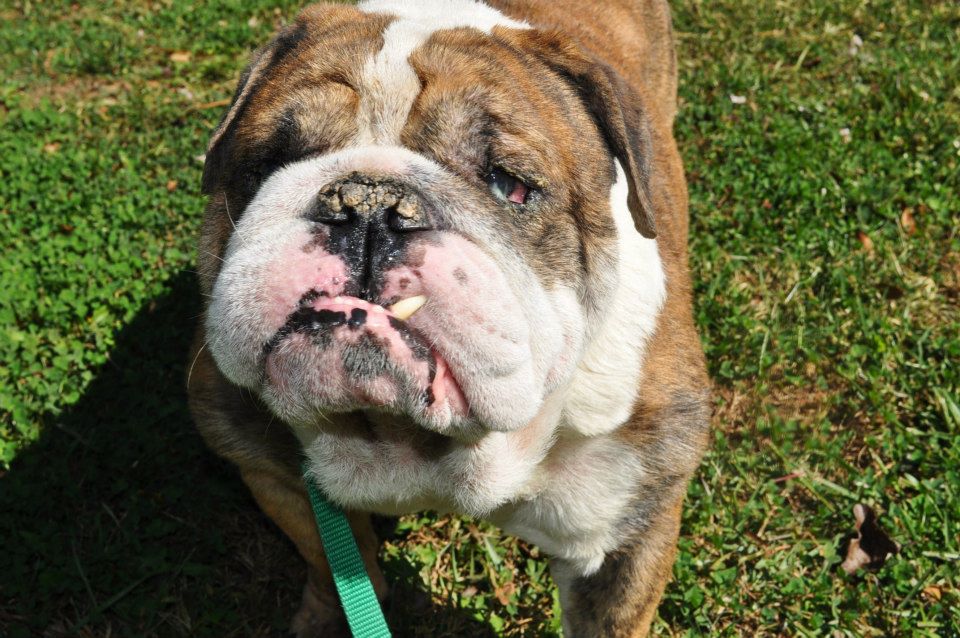What Causes Cherry Eye In Bulldogs?
Cherry eye is a common eye condition seen in bulldogs and other breeds that can affect one or both eyes and cause the third eyelid to protrude from the eye socket.
It is caused by a weakened or damaged tear gland, which causes the third eyelid to become swollen and protrude outwards from the eye socket.
This article will discuss what causes cherry eye in bulldogs, how to diagnose and treat it, and how to prevent it from happening again.
What is Cherry Eye?
Contents
- 1 What is Cherry Eye?
- 2 Causes of Cherry Eye in Bulldogs
- 3 Symptoms of Cherry Eye in Bulldogs
- 4 Diagnosis of Cherry Eye in Bulldogs
- 5 Treatment of Cherry Eye in Bulldogs
- 6 Prevention Of Cherry Eye In Bulldogs
- 7 Causes of Cherry Eye In Bulldogs
- 8 Common Complications Associated With Cherry Eye In Bulldogs
- 9 Conclusion
Cherry eye is an inflammation and swelling of the third eyelid that occurs when the tear gland becomes weak or damaged, causing it to protrude outwards from the eye socket and give off a characteristic cherry-like appearance.
The condition often affects one or both eyes and can be accompanied by redness, irritation, tearing, discharge, and pain if left untreated for too long.
If caught early enough, it can be treated with antibiotics or anti-inflammatory medications.
However if left untreated for too long surgical intervention may be necessary to correct the condition permanently.
Causes of Cherry Eye in Bulldogs
The exact cause of cherry eyes is still unknown.
However, there are several factors that have been identified as potential contributors, such as genetics, trauma/injury to the area surrounding the tear gland, environmental factors, and even certain diseases like distemper or canine herpes virus that can weaken the immune system.
In addition, some studies suggest that certain breeds may be predisposed to developing cherry eyes due to their anatomy.
Symptoms of Cherry Eye in Bulldogs
The most obvious symptom associated with cherry eye is a bulging third eyelid that has a characteristically red or cherry-like appearance.
However, there are other symptoms associated with this condition, such as redness around the affected area, irritation, tearing, discharge from the affected areas, and pain when touching near or around the affected areas.
If you notice any of these symptoms in your bulldog, then you should seek immediate veterinary attention.
Diagnosis of Cherry Eye in Bulldogs
Cherry eye, or prolapse of the third eyelid, is a condition where the gland of the third eyelid protrudes out of the orbit of the eye. This gland produces tears that help keep the eye moist and lubricated. Cherry eyes with prolapsed glands can impair vision by disrupting tear drainage.
Cherry eyes have two types: mild and severe. Mild cherry eye occurs when the gland protrudes out of the orbit but does not cause vision impairment. In severe cases, the gland prolapses out of the orbit and interferes with vision, causing glaucoma, developmental problems, and corneal ulcers.
Cherry eye often affects cocker spaniels, bulldogs, and English cocker spaniels. Other breeds can develop cherry eyes as well.
Cherry eye is diagnosed by your veterinarian through a physical examination, a detailed history, and an ophthalmic examination.
Treatment depends on the severity of the condition. Mild cherry eye can be treated with anti-inflammatory medications and eye drops. Severe cherry eye requires surgery to fully replace the gland back in the orbit of the eye.
Treatment of Cherry Eye in Bulldogs
Cherry eye is a condition that is common in bulldog breeds.
This condition is characterized by the third eyelid becoming inverted or prolapsing into the eye socket, causing the cornea to become inflamed.
Cherry eyes can be very irritating for your pet and make it harder for them to see.
The condition of cherry eye becomes worse when your pet is sleeping, causing discomfort.
This condition is categorized into three levels: mild, moderate, and severe.
Cherry eye is caused by the prolapse of the third eyelid, which is a result of an inflammation of the nictitans gland.
The nictitans gland produces mucus that lubricates the eye and takes in debris.
When the gland becomes inflamed, it becomes overactive, causing the gland to enlarge and prolapse into the eye socket.
This causes the eyelashes to become inverted, resulting in the formation of a cherry eye.
Treatment of cherry eye in bulldogs depends on how severe the condition is. Your vet will help you determine the severity of the condition by diagnosing your pet’s condition.
Mild Cherry Eye
With mild cherry eye, the prolapse of the third eyelid is minor and only affects a small portion of your pet’s eye.
Your pet is not in a lot of pain, and they can still open their eyes normally, although they may have discomfort and irritation in their eyes.
Moderate Cherry Eye
Moderate cherry eye is a more severe form of cherry eye, where your pet’s third eyelid covers more than 50% of the eye.
With moderate cherry eye, the eye is not entirely closed, but your pet’s vision becomes blurry, and they may find it difficult to open their eyes normally. Your dog may also show signs of irritation, pain, and swelling.
Severe Cherry Eye
Severe cherry eye is the most severe form of cherry eye, where the third eyelid covers more than 90% of the eye.
Your pet’s vision becomes cloudy, and the eye may not be entirely closed. Your pet may have difficulty opening their eyes or show irritability and discomfort in their eyes.
When your dog has a severe case of cherry eye, your vet may recommend surgery to remove the prolapsed third eyelid.
However, they first want to ensure that the condition is not caused by a more serious condition that requires immediate medical attention.
Before surgery, your vet will administer an anesthetic to your pet to relax them during the procedure.
Prevention Of Cherry Eye In Bulldogs
Cherry eye is a common eye disease in bulldog breeds, and it is most commonly seen in dogs between the ages of two and six.
Cherry eye occurs when the gland of the third eyelid (which usually produces tears) becomes inflamed or infected, causing the eyelid to thicken and bulge out.
Luckily, this condition is easily treatable, and with proper treatment, your dog should be back to normal within two months.
Begin By Consulting A Vet
Your veterinarian will first examine your dog and may prescribe antibiotics to clear up the infection.
The vet may also give your dog a painkiller to help alleviate the discomfort. If the gland does not improve within two months, the vet may surgically remove it.
Treat Your Dog At Home
After consulting your vet, you can begin treating your dog at home. First, apply warm compresses to your dog’s eyes for 10 minutes, two to three times per day.
You can also apply antibiotic ointment to the eyes. To relieve the discomfort, give your dog ibuprofen or acetaminophen.
Clean Your Dog’s Eyes
To clean your dog’s eyes, use sterile saline solution.
If you notice any discharge from your dog’s eyes, gently wipe the area with a cotton ball or a soft cloth.
You can also take your dog to a professional groomer for a professional cleaning, if needed.
Consider Surgery
If your dog’s eye does not improve with home treatment, or if your Bulldog is in pain, the vet may recommend surgery to remove the gland.
The vet will first administer an anesthetic, then make a small incision in the eye and remove the gland. This procedure often only takes a few minutes and is not painful for your dog.
Causes of Cherry Eye In Bulldogs
Cherry eye is one of the most common conditions found in bulldogs. It’s a condition that causes the tear gland of the third eyelid to bulge out of the eye socket, resulting in a red, swollen eye.
The most common causes of cherry eye are:
- Eye injury – Any blow to the face can cause the eye to bruise or rupture, which leads to a rupture of the third eyelid’s gland.
- Breed predisposition – Certain breeds of dogs have an increased chance of developing cherry eyes. These breeds include bulldogs, Boston terriers and Shih Tzus.
- Eyelid malposition – Sometimes, the gland of the eyelid can be misaligned in the eye socket, which can cause the gland to protrude out.
- Trauma – Sometimes, the gland of the eyelid can rupture because of trauma, such as fighting with another animal or getting hit by a car.
- Allergies – Allergies can also cause the gland to rupture out of the eyelid.
- Eyelid tumors – Tumors, cysts, and eye infections can also lead to the rupture of the gland.
Common Complications Associated With Cherry Eye In Bulldogs
If left untreated for too long, then there are several complications associated with cherry eye in French bulldogs including but not limited to increased infection risk due to a weakened immune system caused by prolonged inflammation and swelling at the site.
Cherry eyes in French bulldogs can cause eye pain, inflammation, and redness.
It’s easy for bacteria to get into the cherry eye in French bulldogs, which may result in an infection.
Infections can cause the eyeball to swell and put pressure on the eyeball’s visual structures, damaging them.
Also Read: How to Treat French Bulldog Eye Problems
Conclusion
Cherry eye is a congenital condition where the third eyelid (known as the nictitating membrane) protrudes through the eye, creating a red, swollen appearance.
Cherry eye is common in dogs and occurs in about 1 out of every 5 dogs. However, it’s much more common in certain breeds, such as bulldogs.
The condition occurs because the nictitating membrane is underdeveloped or doesn’t form properly. The cause of cherry eye in bulldogs is unclear.
Some experts think that the condition is caused by a combination of genetics and environmental factors. However, most experts believe that cherry eye in bulldogs are caused by genetics.
Overall, cherry eye is harmless in bulldogs and does not affect the dog’s vision or lifespan. It only results in a red, swollen appearance that is easy to fix.




